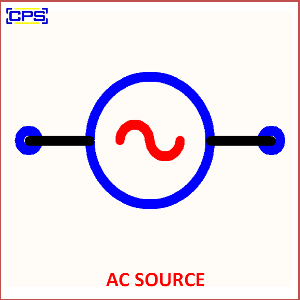An AC source (Alternating Current source) is an electrical energy source that provides an alternating current, which periodically reverses its direction and changes its magnitude over time. The voltage of an AC source typically follows a sinusoidal waveform, although other waveforms like square or triangular waves can also be used in certain applications.

Key Characteristics of an AC Source:
- Frequency: The rate at which the current alternates, measured in hertz (Hz). For example, the standard frequency is 50 Hz in many countries and 60 Hz in others.
- Amplitude: The maximum voltage or current provided by the source.
- Phase: The offset of the waveform relative to a reference point in time.
- Waveform: The shape of the alternating voltage or current (e.g., sine wave, square wave, triangular wave).
AC sources are commonly used in power systems for residential, commercial, and industrial applications because they allow efficient transmission of electricity over long distances. Examples include wall outlets, AC generators, and inverters.
